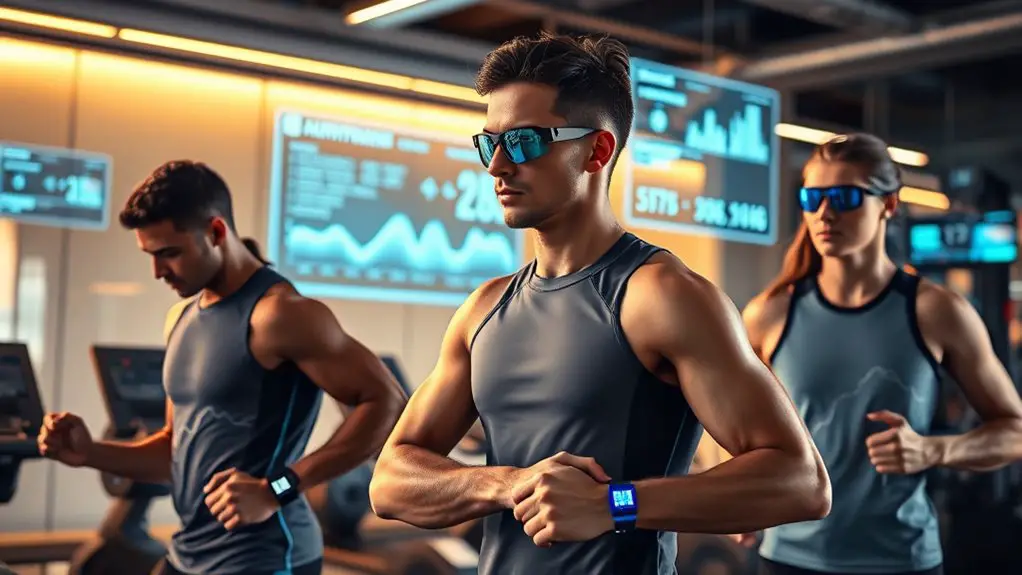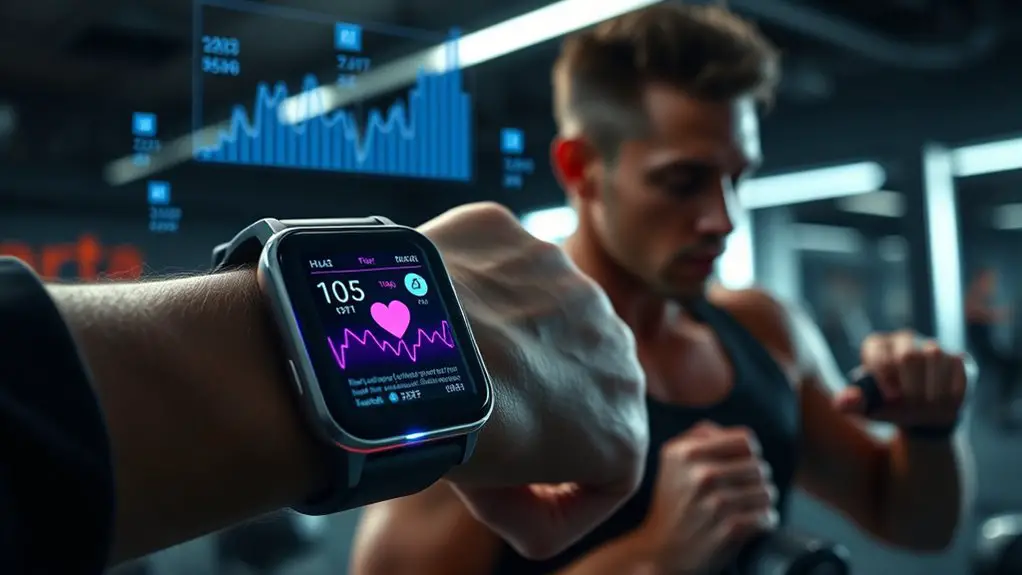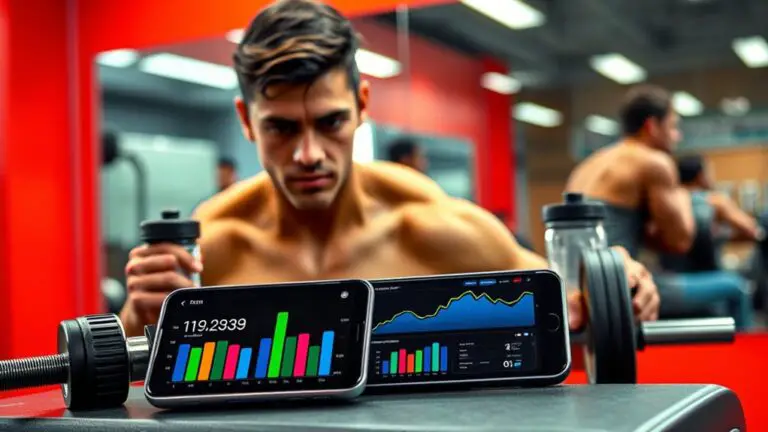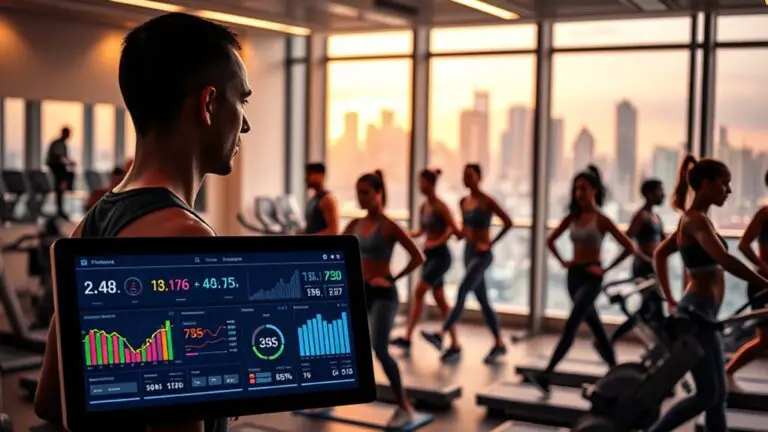The Future of Wearable Tech in Gym Performance Tracking

Wearable tech is reshaping how you track gym performance. These devices offer real-time data on heart rate, calories burned, and even muscle engagement, letting you optimize your workouts like never before. Innovations like AI coaching and advanced biometric sensors are personalizing your fitness journey. However, challenges like data accuracy and battery life remain. As these technologies evolve, they’ll change gym culture, making fitness more engaging and community-driven. Keep exploring to uncover the full potential of this tech revolution.
The Evolution of Wearable Fitness Technology

Over the past two decades, wearable fitness technology has transformed from simple pedometers into sophisticated devices that can monitor everything from heart rate to sleep patterns. You’ve likely noticed how fitness trends have shifted to embrace these advanced gadgets, making them essential tools for anyone serious about their health. Today’s wearables not only track your activity levels but also provide insights into your overall well-being through seamless device integration with smartphones and fitness apps. This integration allows you to analyze your data in real time, helping you set and achieve personal fitness goals more effectively. With features like GPS tracking and heart rate variability monitoring, these devices cater to a wide range of fitness needs. As you navigate this evolving landscape, embracing wearable tech can enhance your workout experience, offering motivation and accountability that keep you on track. The evolution of this technology is a reflection of our growing commitment to personal health.
Key Innovations Shaping the Future
As wearable fitness technology continues to evolve, several key innovations are emerging that promise to redefine how we approach gym performance tracking. AI integration is leading the charge, enabling devices to analyze your workout patterns and suggest improvements. Biometric sensors are becoming more sophisticated, allowing for real-time monitoring of your body’s metrics, which enhances performance insights. Smart fabrics are also gaining traction, providing comfort while seamlessly collecting data during your workouts.
Moreover, gamification strategies are making fitness engaging by turning workouts into challenges, fostering motivation. Augmented reality can enhance your training experience by overlaying critical information during exercises. Cloud connectivity guarantees your data is accessible across devices, but it raises concerns about user privacy and data security. As these innovations converge, they’ll not only optimize performance tracking but also address the need for secure, user-friendly fitness solutions that prioritize your privacy. Welcome to the future of gym performance tracking!
Real-Time Data and Personalized Insights

When you step into the gym, having access to real-time data can transform your workout experience. With wearable tech, you can monitor your heart rate, calories burned, and even muscle engagement as you move through your routine. This real-time analytics allows you to make immediate adjustments to your intensity, ensuring you maximize each session’s effectiveness.
Imagine having personalized coaching right on your wrist; it’s like having a trainer dedicated solely to you. These insights can guide you to push harder or ease off, depending on your body’s feedback. Additionally, tracking your progress over time helps you set realistic goals and celebrate milestones, keeping you motivated.
As you embrace this technology, you’ll find that workouts become more tailored to your needs, leading to improved performance and results. It’s not just about tracking numbers; it’s about optimizing your fitness journey through immediate and actionable insights.
Challenges and Limitations of Wearable Tech
Despite the many advantages of wearable tech in gym performance tracking, several challenges and limitations can hinder its effectiveness. You might encounter issues that affect your overall experience and the reliability of the data you receive. Here are some key challenges to take into account:
Wearable tech offers benefits for gym performance tracking, but challenges like accuracy and battery life can impact effectiveness.
- Accuracy concerns: Devices may struggle to provide precise measurements, leading to misleading data.
- Battery limitations: Frequent charging can interrupt your workouts, making it cumbersome to rely on the tech.
- Privacy issues: Sharing personal data can raise concerns about how your information is stored and used.
- Compatibility challenges: Not all devices sync seamlessly with apps or other wearable technologies, limiting functionality.
- User adherence: It can be tough to consistently wear the devices, impacting the quality of the data collected.
Addressing these issues is essential for maximizing the benefits of wearable tech in your fitness journey.
The Impact on Gym Culture and Fitness Communities

Wearable tech is reshaping not just individual fitness journeys but also the broader gym culture and fitness communities. These devices foster community engagement by allowing members to share their progress, challenges, and achievements in real time. This connectivity enhances fitness motivation, as seeing others’ successes can inspire you to push your limits.
| Feature | Impact on Culture | Example |
|---|---|---|
| Real-time data sharing | Increased accountability | Sharing workout stats |
| Social challenges | Enhanced camaraderie | Group step competitions |
| Progress tracking | Goal-oriented community | Monthly performance meetups |
| Health insights | Holistic fitness approach | Workshops on data usage |
As gyms adopt these technologies, the sense of belonging strengthens, creating environments where support and motivation thrive. Ultimately, wearable tech not only tracks your performance but also amplifies the collective spirit of fitness communities.
Frequently Asked Questions
What Types of Wearable Tech Are Best for Specific Sports Activities?
When it comes to wearable tech for specific sports activities, smart clothing and sport-specific sensors are your best bet. For runners, look for shirts with integrated heart rate monitors. Cyclists might benefit from sensors that track cadence and speed. Swimmers can use waterproof smart wear that monitors stroke efficiency. Each sport demands unique metrics, so choosing the right tech tailored to your activity will enhance your performance and training experience considerably.
How Do Wearables Improve Recovery Times for Athletes?
When you think about enhancing your recovery, wearables might just be your secret weapon. They track performance metrics, providing insights that help you understand when to push harder and when to take a step back. With advanced recovery algorithms, these devices optimize your downtime, ensuring you’re not just resting, but truly recovering. By analyzing your data, they guide you towards quicker recovery, letting you bounce back stronger and ready for your next challenge.
Can Wearable Tech Track Mental Health During Workouts?
Yes, wearable tech can track mental health during workouts. By incorporating stress monitoring features, these devices can measure physiological responses like heart rate variability, which reflects your emotional resilience. You’ll gain insights into your mental state while exercising, helping you understand how stress affects your performance. This data empowers you to make adjustments for better focus and motivation, ultimately enhancing your overall workout experience and mental well-being.
Are There Privacy Concerns With Wearable Fitness Devices?
Imagine your fitness tracker sharing your heart rate and location data without your knowledge. That’s a real concern with wearable devices. Privacy issues arise when it comes to data security and user consent. If companies don’t clearly communicate how they’ll use your data, you might unknowingly expose sensitive information. Always read the privacy policies and adjust your settings to guarantee you’re comfortable with what you’re sharing. Your data should remain yours!
How Much Do Advanced Wearable Devices Typically Cost?
When considering advanced wearable devices, you’ll find prices can vary considerably. Typically, you’re looking at anywhere from $100 to over $500, depending on features. It’s crucial to weigh your budget considerations against your fitness goals. Device comparisons can help you identify which features you truly need, whether it’s heart rate monitoring or GPS tracking. Investing wisely will guarantee you get the best value for your fitness journey without overspending.





